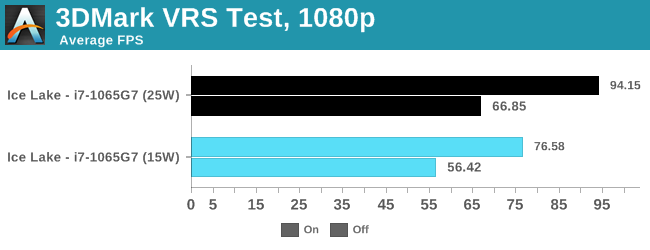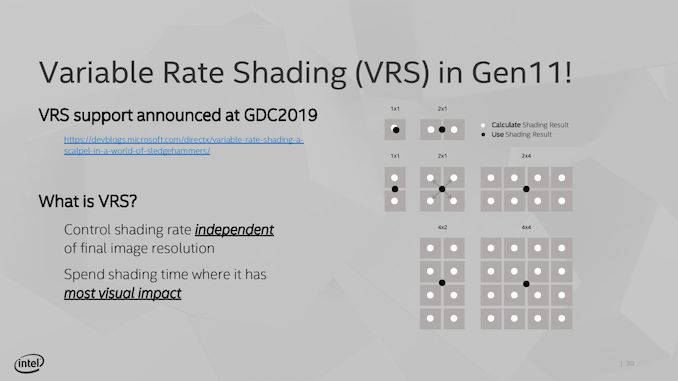The Ice Lake Benchmark Preview: Inside Intel's 10nm
by Dr. Ian Cutress on August 1, 2019 9:00 AM EST- Posted in
- CPUs
- Intel
- GPUs
- 10nm
- Core
- Ice Lake
- Cannon Lake
- Sunny Cove
- 10th Gen Core
Gaming Results (15W and 25W)
One of the biggest changes to the Ice Lake design is in the integrated graphics – Intel is now giving more focus and more die area to graphics, something it has arguably been neglecting for several years now. With Ice Lake, we move to a Gen11 graphics architecture, which is almost like the previous Gen9.5 but now with added support for variable rate shading (VRS), moving from 24 EUs to 64 EUs, and memory support up from LPDDR3-2133 to LPDDR4X-3733.


World of Tanks is a very CPU driven benchmark, and having the extra frequency of the 25W processor does help here. We're getting a sizeable uplift from Whiskey Lake, due to the extra EUs and memory frequency.


Our Final Fantasy test seemed to regress in 25W mode, although still within the noise. This test is still GPU bound, so adding the extra TDP to the CPU didn't actually help much. However, comparing to the Whiskey Lake integrated graphics, we've got over a 2x speedup.


Similarly with Civilization, with what is normally our 'IGP' settings, we are still GPU limited here.
One of Intel's newest features is Variable Rate Shading.
If developers add the option, soon to be an easy checkbox in Unity and Unreal, the game can decide to control the rate at which it shades pixels, from calculating every pixel down using one result across a 4x4 grid, to save compute power. Currently the only way to test this is with the 3DMark functional demo.

The new VRS test in 3DMark is designed as a feature test to show the potential uplift effect from enabling variable rate shading within a game. In both 15W and 25W modes, the data saw a good uplift, and we seemed to get more out of the 25W mode than the 15W mode.














261 Comments
View All Comments
The_Assimilator - Thursday, August 1, 2019 - link
Not to mention that all Intel's CPU fabs have been on 14nm for so long that the capital costs are long paid off.I think we will see ICL on desktop via 14nm, simply because Intel can't afford to not compete with Zen 2. We won't get the full 20% IPC uplift because Intel will have to spend some of that to deal with 14nm's power/heat issues at high frequencies, but even a 10% bump would be enough to decisively regain the performance crown from Zen 2.
dwbogardus - Thursday, August 1, 2019 - link
Pretty much every major architectural change and most every process shrink Intel has made over decades has initially resulted in only very modest improvements. But over time, as volumes and yields improved, they did process tweaks and minor die spins, and the yield had higher frequencies gradually improved. The very first Pentiums/Pentium Pro's struggled to out-perform the then-fastest 80486DX2-66's, on then-existing applications. There has been a slow, by consistently steady over decades improvement in IPC, and generally in frequency, with temporary setbacks in frequency at each new process introduction. But over time, they always ratchet up, with the cumulative effect over the years being very dramatic. While we're all surprised and disappointed that it has taken as long as it has for Intel to get 10 nm out, no one should be surprised that initial yields and frequencies are very modest. They always are, but they always improve, and in the case of 14 nm, they managed to improve them so much that they have been hard to let go of and move on from. In fact, 14 nm is still the best fit for some applications, and will remain so for so time.nevcairiel - Thursday, August 1, 2019 - link
Unfortunately Intel decided a long time ago to not bother to backport Ice Lake to 14nm. Ice Lake had been "done" for years, basically, afterall.On the other hand, they did say that in the future, and with growing uncertainty of process gains, they want to develop architectures in a manner more independent from the actual process, so hopefully Ice Lake is the last µarch thats very tightly married to its process.
hbsource - Thursday, August 1, 2019 - link
Was that an HST reference with the Good Thing trademark?konbala - Thursday, August 1, 2019 - link
How does Integer Scaling working out to be? Really curious, can’t wait to play games smoothly at low res.Alistair - Thursday, August 1, 2019 - link
Kind of what we were expecting, which isn't much. 3 percent ST gains. Can now play AAA titles at 720p at 19fps... not exciting. We don't even get an upgrade from 4 to 6 cores at the same price, like what happened in the desktop. Terrible if you ask me. Guess I'll be keeping my laptop another year.twotwotwo - Thursday, August 1, 2019 - link
Curious if this ends up a return to Intel's old routine or if there's still constrained supply, etc. In particular, the longer 10nm server chips take to arrive, the longer AMD could grow off server revenue.Two tick+tocks a few weeks apart! Busy times for AT, heh.
trivik12 - Thursday, August 1, 2019 - link
Obviously AMD Loons are nervous. Intel will ultimately figure out process issues and then AMD will be back where they were few years back.Alistair - Thursday, August 1, 2019 - link
Maybe you didn't understand what you just read. This is the smallest improvement in CPU performance that Intel has had for years in mobile. Go look at that image again.https://images.anandtech.com/doci/14664/Blueprint%...
maroon1 - Thursday, August 1, 2019 - link
The iGPU gain is massive